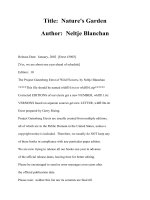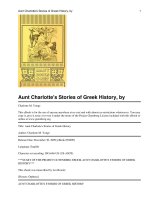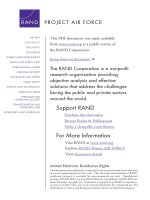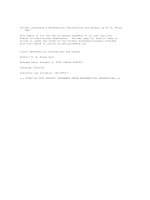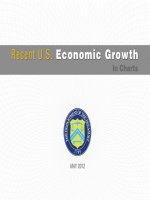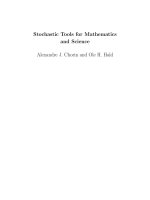DINAH ZIKE''''S TEACHING MATHEMATICS WITH FOLDABLES ppt
Bạn đang xem bản rút gọn của tài liệu. Xem và tải ngay bản đầy đủ của tài liệu tại đây (2.71 MB, 103 trang )
Author
Dinah Zike, M. Ed.
Educational Consultant
San Antonio, Texas
Copyright © by The McGraw-Hill Companies, Inc. All rights reserved. Printed in the United States
of America. Except as permitted under the United States Copyright Act, no part of this publication
may be reproduced or distributed in any form or by any means, or stored in a database or retrieval
system, without the prior written permission of the publisher.
Send all inquiries to:
Glencoe/McGraw-Hill
8787 Orion Place
Columbus, OH 43240
Part of ISBN 0-07-830413-X Teaching Mathematics with Foldables
1 2 3 4 5 6 7 8 9 10 045 11 10 09 08 07 06 05 04 03 02
Glencoe/McGraw-Hill
Letter from Dinah Zike . . . . . . . . . . . . . . . . . . . . .v
Introduction to Foldables
Why Use Foldables in Mathematics? . . . . . .vi
Correlation of Foldables to
Glencoe Mathematics . . . . . . . . . . . . . . . .vii
Foldable Basics . . . . . . . . . . . . . . . . . . . . . . .1
Selecting the Appropriate Foldable . . . . . . . .3
Folding Instructions
Basic Foldable Shapes . . . . . . . . . . . . . . . . . . . . . .5
1-Part Folds
Half Book . . . . . . . . . . . . . . . . . . . . . . . . . . .6
Folded Book . . . . . . . . . . . . . . . . . . . . . . . . .7
Bound Book . . . . . . . . . . . . . . . . . . . . . . . . .8
Two-Tab Book . . . . . . . . . . . . . . . . . . . . . . . .9
2-Part Folds
Matchbook . . . . . . . . . . . . . . . . . . . . . . . . .10
Pocket Book . . . . . . . . . . . . . . . . . . . . . . . .11
Shutter Fold . . . . . . . . . . . . . . . . . . . . . . . . .12
3-Part Folds
Trifold Book . . . . . . . . . . . . . . . . . . . . . . . .13
Three-Tab Book . . . . . . . . . . . . . . . . . . . . . .14
Three-Tab Book Variations . . . . . . . . . . . . .15
Pyramid Fold or Mobile . . . . . . . . . . . . . . . .16
4-Part Folds
Layered-Look Book . . . . . . . . . . . . . . . . . . .17
Four-Tab Book . . . . . . . . . . . . . . . . . . . . . .18
Envelope Fold . . . . . . . . . . . . . . . . . . . . . . .19
Standing Cube . . . . . . . . . . . . . . . . . . . . . . .20
Four-Door Book . . . . . . . . . . . . . . . . . . . . .21
Top-Tab Book . . . . . . . . . . . . . . . . . . . . . . .22
Accordion Book . . . . . . . . . . . . . . . . . . . . .24
Any Number of Parts
Pop-Up Book . . . . . . . . . . . . . . . . . . . . . . . .25
Folding into Fifths . . . . . . . . . . . . . . . . . . . .26
Folded Table, Chart, or Graph . . . . . . . . . . .27
Folding a Circle into Tenths . . . . . . . . . . . . .28
Circle Graph . . . . . . . . . . . . . . . . . . . . . . . .29
Concept-Map Book . . . . . . . . . . . . . . . . . . .30
Vocabulary Book . . . . . . . . . . . . . . . . . . . . .31
Projects Using Folds
Billboard Project . . . . . . . . . . . . . . . . . . . . .32
Sentence-Strip Holder . . . . . . . . . . . . . . . . .33
Sentence Strips . . . . . . . . . . . . . . . . . . . . . .34
Math Activities using Foldables
Number Systems
Whole Numbers . . . . . . . . . . . . . . . . . . . . . .35
Integers . . . . . . . . . . . . . . . . . . . . . . . . . . . .36
Integers: Adding and Subtracting . . . . . . . . .37
Integers: Multiplying and Dividing . . . . . . .38
Rational Numbers . . . . . . . . . . . . . . . . . . . .39
Rational Numbers: Fractions . . . . . . . . . . . .40
Rational Numbers: Decimals . . . . . . . . . . . .41
Percents . . . . . . . . . . . . . . . . . . . . . . . . . . . .42
Ratios . . . . . . . . . . . . . . . . . . . . . . . . . . . . .43
Proportions . . . . . . . . . . . . . . . . . . . . . . . . .43
Irrational Numbers . . . . . . . . . . . . . . . . . . . .44
Real Number System . . . . . . . . . . . . . . . . . .44
Algebraic Patterns and Functions
Sets and Variables . . . . . . . . . . . . . . . . . . . .45
Expressions . . . . . . . . . . . . . . . . . . . . . . . . .46
Properties . . . . . . . . . . . . . . . . . . . . . . . . . .47
Equations . . . . . . . . . . . . . . . . . . . . . . . . . . .48
Inequalities . . . . . . . . . . . . . . . . . . . . . . . . .49
Relations and Functions . . . . . . . . . . . . . . . .50
Factors . . . . . . . . . . . . . . . . . . . . . . . . . . . . .51
Multiples . . . . . . . . . . . . . . . . . . . . . . . . . . .52
Monomials and Polynomials . . . . . . . . . . . .53
Powers and Exponents . . . . . . . . . . . . . . . . .54
Sequences . . . . . . . . . . . . . . . . . . . . . . . . . .55
Matrices . . . . . . . . . . . . . . . . . . . . . . . . . . .56
Geometry
Points . . . . . . . . . . . . . . . . . . . . . . . . . . . . .57
Lines and Line Segments . . . . . . . . . . . . . . .57
Rays . . . . . . . . . . . . . . . . . . . . . . . . . . . . . .57
Angles . . . . . . . . . . . . . . . . . . . . . . . . . . . . .58
Angle Relationships . . . . . . . . . . . . . . . . . . .58
Planes . . . . . . . . . . . . . . . . . . . . . . . . . . . . .59
Polygons . . . . . . . . . . . . . . . . . . . . . . . . . . .60
Triangles . . . . . . . . . . . . . . . . . . . . . . . . . . .61
Right Triangles . . . . . . . . . . . . . . . . . . . . . .62
Right Triangle Trigonometry . . . . . . . . . . . .63
©Glencoe/McGraw-Hill iii Teaching Mathematics with Foldables
Table of Contents
Quadrilaterals . . . . . . . . . . . . . . . . . . . . . . .64
Squares, Rectangles, and Rhombi . . . . . . . .65
Parallelograms . . . . . . . . . . . . . . . . . . . . . . .66
Trapezoids . . . . . . . . . . . . . . . . . . . . . . . . . .67
Circles . . . . . . . . . . . . . . . . . . . . . . . . . . . . .68
Three-Dimensional Figures . . . . . . . . . . . . .69
Prisms and Cylinders . . . . . . . . . . . . . . . . . .70
Pyramids and Cones . . . . . . . . . . . . . . . . . .71
Coordinate Geometry . . . . . . . . . . . . . . . . . .72
Slope . . . . . . . . . . . . . . . . . . . . . . . . . . . . . .73
Graphing Equations and Inequalities . . . . . .74
Measurement
Metric Measurement . . . . . . . . . . . . . . . . . .75
Length, Width, and Height . . . . . . . . . . . . . .75
Distance . . . . . . . . . . . . . . . . . . . . . . . . . . .76
Weight . . . . . . . . . . . . . . . . . . . . . . . . . . . . .76
Vo l ume . . . . . . . . . . . . . . . . . . . . . . . . . . . .77
Temperature . . . . . . . . . . . . . . . . . . . . . . . . .77
Data Analysis and Probability
Statistics . . . . . . . . . . . . . . . . . . . . . . . . . . .78
Stem-and-Leaf Plots . . . . . . . . . . . . . . . . . .79
Box-and-Whisker Plots . . . . . . . . . . . . . . . .79
Fundamental Counting Principle . . . . . . . . .80
Frequency Tables . . . . . . . . . . . . . . . . . . . . .80
Pascal’s Triangle . . . . . . . . . . . . . . . . . . . . .80
Permutations . . . . . . . . . . . . . . . . . . . . . . . .81
Combinations . . . . . . . . . . . . . . . . . . . . . . .81
Probability . . . . . . . . . . . . . . . . . . . . . . . . . .82
Scatter Plots . . . . . . . . . . . . . . . . . . . . . . . . .83
Problem Solving
Problem-Solving Plan . . . . . . . . . . . . . . . . .84
Problem-Solving Strategies . . . . . . . . . . . . .84
Communication
Vocabulary and Writing Definitions . . . . . . 85
Journals . . . . . . . . . . . . . . . . . . . . . . . . . . . .85
Outline, List, and Sequence . . . . . . . . . . . . .86
Concept Maps . . . . . . . . . . . . . . . . . . . . . . .86
Writing Instructions . . . . . . . . . . . . . . . . . . .86
Main Ideas and Note Taking . . . . . . . . . . . .87
Annotations . . . . . . . . . . . . . . . . . . . . . . . . .87
Questioning . . . . . . . . . . . . . . . . . . . . . . . . .87
Representation
Tables and Charts . . . . . . . . . . . . . . . . . . . .88
Circle Graphs . . . . . . . . . . . . . . . . . . . . . . .88
Bar Graphs and Histograms . . . . . . . . . . . . .89
Line Graphs . . . . . . . . . . . . . . . . . . . . . . . . .89
Pictographs . . . . . . . . . . . . . . . . . . . . . . . . .90
Venn Diagrams . . . . . . . . . . . . . . . . . . . . . .90
Index . . . . . . . . . . . . . . . . . . . . . . . . . . . . . . . . . . . . .91
©Glencoe/McGraw-Hill iv Teaching Mathematics with Foldables
©Glencoe/McGraw-Hill v Teaching Mathematics with Foldables
FROM DINAH ZIKE
Dear Teacher,
In this book, you will find instructions for making Foldables as well as ideas on how to use
them. They are an excellent communication tool for students and teachers.
National Math Standards
and Communication Skills
The Principles and Standards for School Mathematics, published by the National
Council of Teachers of Mathematics (NCTM) in 2000, stress the importance of
communication skills in a strong mathematics program. Not all students will
become mathematicians, engineers, or statisticians, but all students need to be able
to think, analyze, and problem solve using skills acquired through the study of
mathematics.
Throughout their lives, students will be called upon to be literate in mathematics—
personally and professionally. They will need to have a basic understanding of
numbers, operations, and quantitative reasoning; patterns, relationships, and
algebraic thinking; geometry; measurement; and probability and statistics to solve
real-life problems involving finances, chance, design, science, fine arts, and more.
Furthermore, students must be able to share the results of their use of mathematics
using various forms of oral and written communication. Foldables are one of many
techniques that can be used to integrate reading, writing, thinking, organizing data,
researching, and other communication skills into an interdisciplinary mathematics
curriculum.
Who, What, When, Why
You probably have seen at least one of the Foldables featured in this book used in
supplemental programs or staff-deveopment workshops. Today, my Foldables are
used internationally. I present workshops and keynotes to over fifty thousand
teachers and parents a year, sharing the Foldables that I began inventing, design-
ing, and adapting over thirty years ago. Around the world, students of all ages are
using them for daily work, note-taking activities, student-directed projects, forms
of alternative assessment, math journals, graphs, charts, tables, and more.
Add and Amend
After workshop presentations, participants would ask me for lists of activities to be
used with the Foldables they had just learned to make. They needed help visualizing
how to convert math data into Foldables. So, over fifteen years ago, I began collect-
ing and sharing the ideas listed in this book. The ideas are organized by topic. The
table for each topic shows the math content being addressed and an appropriate
Foldable. I hope you enjoy making Foldables a part of your math classroom!
©Glencoe/McGraw-Hill v Teaching Mathematics with Foldables
©Glencoe/McGraw-Hill vi Teaching Mathematics with Foldables
INTRODUCTION TO FOLDABLES
Why Use Foldables in Mathematics?
When teachers ask me why they should take time to use the Foldables featured in this book, I
explain that they
. . . quickly organize, display, and arrange information, making it easier for students to grasp
math concepts and master skills.
. . . result in student-made study guides that are compiled as students listen for main ideas,
read for main ideas, and work their way through new concepts and procedures.
. . . provide a multitude of creative formats in which students can present projects, research,
and computations instead of typical poster board or math fair formats.
. . . replace teacher-generated writing or photocopied sheets with student-generated print.
. . . incorporate the use of such skills as comparing and contrasting, recognizing cause and
effect, and finding similarities and differences into daily work and long-term projects. For
example, these Foldables can be used to compare and contrast student explanations and
procedures for solving problems to the explanations presented by other students and
teachers.
. . . continue to “immerse” students in previously learned vocabulary and concepts, providing
them with a strong foundation that they can build upon with new observations,
experiences, and knowledge.
. . . can be used by students or teachers to easily communicate data through graphs, tables,
charts, models, and diagrams, including Venn diagrams.
. . . allow students to make their own math journals for recording main ideas, problem-solving
strategies, examples, questions that arise during classwork, and personal experiences that
occur during learning.
. . . can be used as alternative assessment tools by teachers to evaluate student progress or by
students to evaluate their own progress.
. . . integrate language arts, the sciences, and social sciences into the study of mathematics.
. . . provide a sense of student ownership in the mathematics curriculum.
©Glencoe/McGraw-Hill vii Teaching Mathematics with Foldables
Number Systems
Whole Numbers ✓✓✓✓
Integers ✓✓✓✓✓
Integers: Adding ✓✓✓✓
and Subtracting
Integers: Multiplying
✓✓✓✓
and Dividing
Rational Numbers ✓✓✓✓✓
Rational Numbers:
✓✓✓✓
Fractions
Rational Numbers:
✓✓✓✓
Decimals
Percents ✓✓✓✓✓
Ratios ✓✓✓✓
Proportions ✓✓✓✓✓
Irrational Numbers ✓✓ ✓
Real Number System ✓✓ ✓
Patterns and Functions
Sets and Variables ✓✓✓✓✓ ✓
Expressions ✓✓✓✓✓ ✓
Properties ✓✓✓✓✓ ✓
Equations ✓✓✓✓✓ ✓
Inequalities ✓✓✓✓✓ ✓
Relations and
✓✓✓✓✓ ✓
Functions
Factors ✓✓ ✓✓
Multiples ✓✓ ✓✓
Monomials and
✓✓✓ ✓
Polynomials
Powers and Exponents ✓✓✓✓✓ ✓
Sequences ✓✓✓✓
Matrices ✓✓✓✓
Geometry
Points ✓✓✓✓✓✓✓
Lines and Line
✓✓ ✓
Segments
Rays ✓
Angles ✓✓✓✓ ✓✓
Angle Relationships ✓
Planes ✓
Polygons ✓✓✓✓ ✓
Triangles ✓✓✓✓ ✓
Right Triangles ✓✓✓✓✓✓✓
Mathematics: Mathematics: Mathematics:
Foldable
TM
Topic
Applications and Applications and Applications and
Pre-Algebra Algebra 1 Geometry Algebra 2
Connections, Connections, Connections,
Course 1 Course 2 Course 3
Correlation of Foldables
TM
to Glencoe Mathematics
INTRODUCTION TO FOLDABLES
©Glencoe/McGraw-Hill viii Teaching Mathematics with Foldables
INTRODUCTION TO FOLDABLES
Algebra and Right
✓✓✓✓
Triangles
Quadrilaterals ✓✓ ✓ ✓
Squares, Rectangles,
✓✓✓✓ ✓
and Rhombi
Parallelograms ✓✓ ✓ ✓
Trapezoids ✓✓✓ ✓
Circles ✓✓✓✓ ✓
Three-Dimensional
✓✓✓✓ ✓
Figures
Prisms and Cylinders ✓✓✓✓ ✓
Pyramids and Cones ✓✓ ✓
Coordinate Geometry ✓✓✓✓✓✓✓
Slope ✓✓✓✓✓✓
Graphing Equations
✓✓✓✓✓✓
and Inequalities
Measurement
Metric Measurement ✓
Length, Width, and
✓
Height
Distance ✓
Weight ✓
Volume ✓
Temperature ✓✓✓✓✓
Data Analysis and Probability
Statistics
Stem-and-Leaf Plots ✓
Box-and-Whisker Plots ✓✓✓
Fundamental Counting
✓✓✓✓ ✓
Principle
Frequency Tables ✓✓✓✓
Pascal’s Triangle ✓✓✓✓✓
Permutations ✓✓✓✓ ✓
Combinations ✓✓✓✓ ✓
Probability ✓✓✓✓✓✓✓
Scatter Plots ✓✓✓✓✓✓
Problem Solving
Problem Solving Plan ✓✓✓✓✓✓✓
Problem Solving
✓✓✓✓✓
Strategies
Communication
Vocabulary and Writing
✓✓✓✓✓✓✓
Definitions
Mathematics: Mathematics: Mathematics:
Foldable
TM
Topic
Applications and Applications and Applications and
Pre-Algebra Algebra 1 Geometry Algebra 2
Connections, Connections, Connections,
Course 1 Course 2 Course 3
Correlation of Foldables
TM
to Glencoe Mathematics
©Glencoe/McGraw-Hill ix Teaching Mathematics with Foldables
INTRODUCTION TO FOLDABLES
Journals ✓✓✓✓✓✓✓
Outline, List, and
✓✓✓✓✓✓✓
Sequence
Concept Map ✓✓✓✓✓✓✓
Writing Instructions ✓✓✓✓✓✓✓
Main Ideas and Note
✓✓✓✓✓✓✓
Taking
Annotations ✓✓✓✓✓✓✓
Questioning ✓✓✓✓✓✓✓
Representation
Tables and Charts ✓✓✓✓✓✓✓
Circle Graphs ✓✓✓✓ ✓
Bar Graphs and
✓✓✓✓✓
Histograms
Line Graphs ✓✓
Pictographs ✓
Venn diagrams ✓✓✓✓✓✓✓
Mathematics: Mathematics: Mathematics:
Foldable
TM
Topic
Applications and Applications and Applications and
Pre-Algebra Algebra 1 Geometry Algebra 2
Connections, Connections, Connections,
Course 1 Course 2 Course 3
Correlation of Foldables
TM
to Glencoe Mathematics
Foldable Basics
What to Write and Where
Teach students to write general information—titles, vocabulary words, concepts, questions, main
ideas, and properties or theorems—on the front tabs of their Foldables. General information is
viewed every time a student looks at a Foldable. Foldables help students focus on and remember
key points without being distracted by other print.
Ask students to write specific information—supporting ideas, student thoughts, answers to
questions, research information, computation steps, class notes, observations, and definitions—
under the tabs.
As you teach, demonstrate different ways in
which Foldables can be used. Soon you will find
that students make their own Foldables and use
them independently for study guides and projects.
With or Without Tabs
Foldables with flaps or tabs create study guides that students can use to self check what they
know about the general information on the front of the tabs. Use Foldables without tabs for
assessment purposes or projects where information is presented for others to view quickly.
INTRODUCTION TO FOLDABLES
Venn Diagram used for assessmentVenn Diagram used as a study guide
©Glencoe/McGraw-Hill 2 Teaching Mathematics with Foldables
What to Do with
Scissors and Glue
I don’t expect secondary students to bring
glue and scissors to math class. Instead, I
set up a small table in the classroom and
provide several containers of glue,
numerous pairs of scissors (sometimes tied
to the table), containers of markers and
colored pencils, a stapler, clear tape, and
anything else I think students might need
to make their Foldables. Don’t be
surprised if students donate unusual
markers, decorative-edged scissors, gel
pens, stencils, and other art items to your publishing table.
The more they make and use graphic organizers, the faster students become at
producing them.
Storing Graphic
Organizers in
Student Portfolios
Turn one-gallon freezer bags into student
portfolios which can be collected and
stored in the classroom. Students can also
carry their portfolios in their notebooks if
they place strips of two-inch clear tape
along one side and punch three holes
through the taped edge.
Have each student write his or her name
along the top of the plastic portfolio with a
permanent marker and cover the writing with two-inch clear tape to keep it from wearing off.
Cut the bottom corners off the bag so it won’t hold air and will stack and store easily.
HINT: I found it more convenient to keep student portfolios in my classroom so
student work was always available when needed and not “left at home” or “in
the car.” Giant laundry-soap boxes make good storage containers for portfolios.
Let Students Use This Book As an Idea Reference
Make this book available to students to use as an idea reference for projects, discussions, extra
credit work, cooperative learning group presentations, and more.
INTRODUCTION TO FOLDABLES
INTRODUCTION TO FOLDABLES
Selecting the Appropriate Foldable
Dividing Math Concepts into Parts
Foldables divide information and make it visual. In order to select the appropriate Foldable,
decide how many parts you want to divide the information into and then determine which
Foldable best illustrates or fits those parts. Foldables that are three-dimensional also make the
student interact with the information kinesthetically.
For example, if you are studying the Properties of Equality you could choose a Foldable that
has five tabs (or sections). On the front tabs write the properties. Under the tabs, explain the
properties in words on one side and in symbols on the other side.
Math Concepts That Can Be Divided into Parts
Algebra Geometry Statistics and Probability
write algebraic expressions draw angles with a protractor determine ranges of sets
evaluate expressions classify polygons interpret scatter plots
sequence steps illustrate quadrilaterals display data collected in plots
list algebraic rules list examples of prisms draw models of combinations
solve equations name ordered pairs
find values for variables graph points
Math Concepts Already Divided into Parts
Algebra Geometry Statistics and Probability
Parts Concept Parts Concept Parts Concept
5Properties of Equality 2 collinear and noncollinear 3 mean, median, mode
3 parentheses, brackets, 2 complementary and 1 Fundamental Counting
and braces supplementary angles Principle
2 equations and inequalities 2 parallel and perpendicular 4 Who, What, When,
Where: Blaise Pascal
2 numeric and algebraic 3 translation, rotation, 2 permutations and
expressions reflection combinations
2 domain and range 6 types of triangles 2 upper quartile and lower
quartile
7properties of addition and 4 SSS, SAS, ASA, AAS 2 dependent and
multiplication independent events
2 LCM and LCD 2 two types of special right 2 probability and odds
triangles
3 monomials, binomials, 6types of quadrilaterals 2 odds in favor and odds
and trinomials against
2 powers and exponents 2 x-axis and y-axis 2 mutually inclusive and
exclusive events
©Glencoe/McGraw-Hill 3 Teaching Mathematics with Foldables
©Glencoe/McGraw-Hill 4 Teaching Mathematics with Foldables
Dividing Skills and Foldables into Parts
Reading, writing, and thinking skills can easily be used with Foldables. The following lists
show examples of skills and activities and a selection of Foldables divided into parts. You may
want to refer to this page as you select activities from the lists of math topics in this book.
(See pages 35–90.)
INTRODUCTION TO FOLDABLES
Foldables Divided into Parts
1 Part 2 Parts
Half Book Two-Tab Book
Folded Book Pocket Book
Matchbook Shutter Fold
Bound Book Matchbook Cut in Half
Concept-Map Book with Two Tabs
3 Parts 4 Parts
Trifold Book Four-Tab Book
Three-Tab Book Standing Cube
Pyramid Book Top-Tab Book
Layered-Look Book Four-Door Book
Concept Map with Three Tabs
Any Number of Parts
Accordion Book Circle Graph
Layered-Look Book Concept-Map Book
Sentence-Strip Holder Vocabulary Book
Folded Table, Chart, or Graph Bound Book
Pyramid Mobile Pocket Books
Top-Tab Book
(three or more sheets of paper)
Skills and Activities Divided into Parts
1 Part 2 Parts
Find the Main Idea Compare and Contrast
Predict an Outcome Cause and Effect
Narrative Writing Similarities and Differences
Descriptive Writing Opposite Operations
Expository Writing
Persuasive Writing
3 Parts 4 Parts
Venn Diagrams Who, What, When, Where
Know?-Like to Know?-Learned? What, Where, When, Why/How
Beginning, Middle, End
Any Number of Parts
Questioning Making and Using Tables
Flow Charts Making and Using Graphs
Vocabulary Words Making and Using Charts
Timelines Sequencing Data or Events
Concept Webs or Maps
©Glencoe/McGraw-Hill 5 Teaching Mathematics with Foldables
Basic Foldable Shapes
The following figures illustrate the basic folds that are referred to throughout the following
section of this book.
Taco Fold Hamburger Fold
Hot Dog Fold
Shutter Fold
Burrito Fold
Valley Fold
Mountain Fold
FOLDING INSTRUCTIONS
©Glencoe/McGraw-Hill 6 Teaching Mathematics with Foldables
Half Book
Fold a sheet of 8
ᎏ
1
2
ᎏ
" ϫ 11" paper in half.
1. This book can be folded vertically like a
hot dog or . . .
2. . . . it can be folded horizontally like a
hamburger.
Use this book for descriptive, expository,
persuasive, or narrative math writing, as well as
graphs, diagrams, or charts.
FOLDING INSTRUCTIONS: 1-PART FOLDS
2
1
©Glencoe/McGraw-Hill 7 Teaching Mathematics with Foldables
Folded Book
1. Make a half book.
2. Fold it in half again like a hamburger. This
makes a ready-made cover, and two small
pages for information on the inside.
Use photocopied worksheets, Internet print outs,
and student-drawn diagrams or maps to make this
book. One sheet of paper can be used for two
activities and two grades.
FOLDING INSTRUCTIONS: 1-PART FOLDS
1
2
When folded, the photocopied sheet becomes a book
for recording notes and questions.
Bound Book
1. Take two sheets of 8
ᎏ
1
2
ᎏ
" ϫ 11" paper
and fold each one like a hamburger. Place
the papers on top of each other, leaving
one sixteenth of an inch between the
mountain tops.
2. Mark both folds one inch from the outer
edges.
3. On one of the folded sheets, cut from the
top and bottom edge to the marked spot
on both sides.
4. On the second folded sheet, start at one of
the marked spots and cut the fold between
the two marks.
5. Take the cut sheet from step 3 and fold it
like a burrito. Place the burrito through
the other sheet and then open the burrito.
Fold the bound pages in half to form an
eight-page book.
©Glencoe/McGraw-Hill 8 Teaching Mathematics with Foldables
Use for math journals. Make large math project books using 11" ϫ 17" paper.
1
2
4
5
3
FOLDING INSTRUCTIONS: 1-PART FOLDS
©Glencoe/McGraw-Hill 9 Teaching Mathematics with Foldables
Two-Tab Book
1. Take a folded book and cut up the valley
of the inside fold toward the mountain top.
This cut forms two large tabs that can be
used front and back for writing and
illustrations.
2. The book can be expanded by making
several of these folds and gluing them
side-by-side.
Use this book for data that occurs in twos, for
example opposite operations.
1
2
FOLDING INSTRUCTIONS: 1-PART FOLDS
3
©Glencoe/McGraw-Hill 10 Teaching Mathematics with Foldables
Matchbook
1. Fold a sheet of 8
ᎏ
1
2
ᎏ
" ϫ 11" paper like
a hamburger, but fold it so that one side
is one inch longer than the other side.
2. Fold the one-inch tab over the short side
forming an envelope-like fold.
3. Cut the front flap in half toward the
mountain top to create two flaps.
Use this book to report on one or two vocabulary
words, questions, or concepts. Collect matchbooks
and use them to make great student-made bulletin
boards.
1
2
FOLDING INSTRUCTIONS: 2-PART FOLDS
©Glencoe/McGraw-Hill 11 Teaching Mathematics with Foldables
Pocket Book
1. Fold a sheet of 8
ᎏ
1
2
ᎏ
" ϫ 11" paper
in half like a hamburger.
2. Open the folded paper and fold one of
the long sides up two inches to form a
pocket. Refold along the hamburger
fold so that the newly formed pockets
are on the inside.
3. Glue the outer edges of the two-inch
fold with a small amount of glue.
4. Optional: Glue a cover around the
pocket book.
Variation: Make a multi-paged
booklet by gluing several pockets
side-by-side. Glue a cover around
the multi-paged pocket book.
Use 3" ϫ 5" index cards inside the pockets.
Store student-made books, such as two-tab
books and folded books in the pockets.
Example of several pocket books glued side-by-side.
1
2
3 4
FOLDING INSTRUCTIONS: 2-PART FOLDS
©Glencoe/McGraw-Hill 12 Teaching Mathematics with Foldables
Shutter Fold
1. Begin as if you were going to make a
hamburger but instead of creasing the paper,
pinch it to show the midpoint.
2. Fold the outer edges of the paper to meet at
the pinch, or mid-point, forming a shutter
fold.
Use this book for data occurring in twos. Or, make
this fold using 11" ϫ 17" paper and smaller
books—such as the half book, journal, and two-
tab book—that can be glued inside to create a
large project full of student work.
1
2
FOLDING INSTRUCTIONS: 2-PART FOLDS
©Glencoe/McGraw-Hill 13 Teaching Mathematics with Foldables
Trifold Book
1. Fold a sheet of 8
ᎏ
1
2
ᎏ
" ϫ 11" paper into thirds.
2. Use this book as is, or cut into shapes. If the
trifold is cut, leave plenty of fold on both
sides of the designed shape, so the book will
open and close in three sections.
Use this book to make charts with three columns
or rows, large Venn diagrams, or reports on data
occurring in threes.
1
2
FOLDING INSTRUCTIONS: 3-PART FOLDS
©Glencoe/McGraw-Hill 14 Teaching Mathematics with Foldables
Three-Tab Book
1. Fold a sheet of paper like a hot dog.
2. With the paper horizontal, and the fold of the
hot dog up, fold the right side toward the
center, trying to cover one half of the paper.
NOTE: If you fold the right edge over first,
the final graphic organizer will open and
close like a book.
3. Fold the left side over the right side to make
a book with three folds.
4. Open the folded book. Place your hands
between the two thicknesses of paper and cut
up the two valleys on one side only. This will
form three tabs.
Use this book for data occurring in threes.
1
2
3
4
FOLDING INSTRUCTIONS: 3-PART FOLDS
Three-Tab Book Variations
Variation A
Draw overlapping circles on the three tabs
to make a Venn Diagram.
Variation B
Cut each of the three tabs in half to make
a six-tab book.
©Glencoe/McGraw-Hill 15 Teaching Mathematics with Foldables
FOLDING INSTRUCTIONS: 3-PART FOLDS
